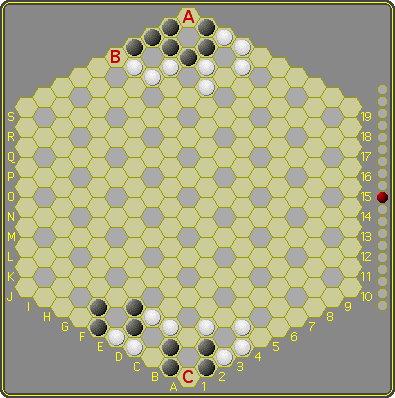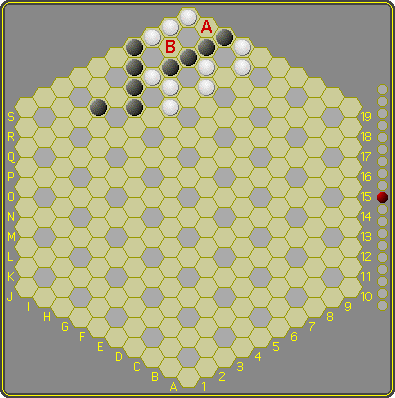Medusa

Medusa is a Go variant invented by Christian Freeling in the early eighties. It is played on a subset of the cells of a base-10 'hexhex' board. As in Go, a cell has four, three or two liberties, depending on whether it belongs to the infield, an edge or a corner. The track on the side allows komi points to be set, and points for refraining from placing a stone to be counted. Since Medusa next to placement also has a limited movement option, refraining from placement is not the same as passing.
Medusa features othelloanian capture and has an additional safety mechanism called a rosette: a group containing six like colored stones around a grey hex lives unconditionally. Seki may occur and suicide is legal.
Medusa has a minimalistic support act called Lotus.
Rules
The game starts on an empty board. Play is on the hexagons. Only the lighter colored cells are part of the board, thus a cell in the center has four neighbours, one on the edge has three and a corner has two. Each player has a sufficient number of bi-colored stones.
Next to the board is a 19-point track with a marker in the center. It can be used to set komi and to keep track of points earned by not placing a stone on the board at one's turn.
Placement and movement options
- White moves first, after which turns alternate. On his turn a player has two options:
- He may place a stone on any vacant cell.
- He may 'move' any or all of his groups.
- He may use either or both. If he uses both, placing a stone must precede movement. If he drops the first option he may move the marker one point towards his side.
Movement
- For movement purposes a group is defined as two or more connected stones of the same color. Moving a group means taking one of its stones and moving it in a staight line over any number of friendly stones in an unbroken row, to land on the first vacant cell beyond.
- No group may move more than once in a turn.
- By movement groups may split or join. If a group moves to contact a friendly group that has not yet moved itself, the latter therewith loses its right to move in that turn. Thus the order of moving groups may make a difference.
Life and death
- A group lives unconditionally if it contains a 'rosette' - six stones around one of the board's 61 dark-colored cells.
- For capturing purposes a single stone is also a group (by definition). A group without a rosette lives as long as it has at least one liberty.
- Assuming none of the groups involved are protected by a rosette, a group that loses its last liberty is captured and reversed immediately to show the opponent's color.
- Capture may result from placement or movement or both. If a capture is the result of placement only, the stones are reversed before the movement phase. Thus the group resulting from the capture has the right to move in the same turn. Groups captured by movement contain at least one stone that has moved, and may not move in the same turn.
- If placement results in one or more opponent's groups losing their last liberty, they are captured whether or not the stone placed has any liberties itself at the time of placement.
- Suicide is legal: if placement results in losing one's own last liberty without killing any opponent's group, the player's own stone or group is reversed before the movement phase.
Object and counting
The game ends by one player's resignation or if both pass completely on successive turns. In the latter case dead stones are removed or reversed. The winner is now the player with the most territory. Territory consists of a player's number of stones on the board plus the number of cells totally surrounded by his stones. The player whose side it is on, also adds the number of points indicated by the marker.
Seki may occur: only cells totally surrounded by one player's color count in a seki.
Examples


In the left diagram, at the top black is safe. A white placement at A is suicidal and gives black a rosette, making movement at B (qs15) useless. If white plays at B, black must answer by completing a rosette at A himself on the next turn.
At the bottom black threatens to connect by capturing the group on the bottom left side. It's white's turn however and the four black stones at the bottom are killed by a suicide placement at C, creating a five stone black group with two liberties, followed by two movements: EC1 and EC3.
The right diagram shows a seki: neither player can occupy A or B without having his stones killed.
Strategy
In general sense Medusa strategy mirrors Go strategy, but there are differences. Invasions in Medusa, including those unlikely to succeed, don't harm as long as the opponent must answer by placement. Failure only makes that the opponent gets some dead stones on cells that would have been part of his territory anyway, while the invader doesn't lose anything in trying. However, if the invading stone is so weak as to require no answer by placement, the invader loses a marker point.
The same holds for overdefensiveness: 'killing' already dead stones doesn't so much change the division of territory, but it gives the opponent the opportunity to refrain from placement and move the marker.
Medusa is highly efficient in that stones that lose their local importance in the course of a game, can often be moved to where they're needed more urgently.
External links
Medusa at mindsports.nl:
![[ext]](images/extlink.gif) http://mindsports.nl/index.php/the-pit/540-medusa
http://mindsports.nl/index.php/the-pit/540-medusa
Medusa at BGG:
![[ext]](images/extlink.gif) http://boardgamegeek.com/boardgame/68851/medusa
http://boardgamegeek.com/boardgame/68851/medusa
Medusa is featured in R. Wayne Schmittberger's 'New Rules for Classic Games' (John Wiley & Sons, Inc. New York; ISBN 0-471-53621-0)
![Sensei's Library [Welcome to Sensei's Library!]](images/stone-hello.png)